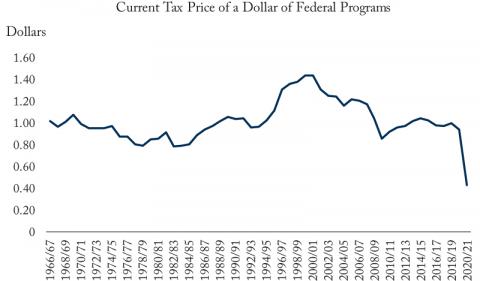From: William B.P. Robson
To: Enthusiasts for, and skeptics about, federal government spending
Date: October 26, 2020
Re: Ottawa’s spending won’t stay cheap
Looked at one way, the federal government’s recent musings about spending tens – even hundreds – of billions more dollars on a raft of new programs seem weird. Nobody thought we could afford such a binge before COVID hammered our economy. How is it a great idea afterward?
Look at it another way, however, and the magical thinking in Ottawa is easier to understand. The crisis pushed the federal government’s revenues down and its spending up. Directionally, that is fine. But a mind-boggling two-thirds hike in program expenses this year has driven the apparent tax cost of a dollar of program spending through the floor. Federal largesse has never looked cheaper.
How cheap? July’s fiscal snapshot suggested Ottawa’s revenue, excluding investment income, will be about $257 billion this year. It also showed spending, excluding interest payments, of $593 billion. Divide the one by the other and you get the apparent tax cost of a dollar of program spending: 43 cents. More than 50 percent off almost any price will find a lot of buyers! No wonder the government keeps adding and extending COVID programs – or that last month’s Speech from the Throne talked about childcare, free drugs, and more money for seniors, infrastructure and comprehensive greening. Borrowing makes the tax cost of all this stuff look low.
Doing the same comparison over time, however, shows that bargain basement prices will not last. Finance Canada’s Fiscal Reference Tables go back to the late 1960s, when budgets were balanced and Ottawa’s debt and interest payments were small. Back then, the feds collected about one dollar in tax for every dollar they spent on programs.
In the 1970s, however, under Pierre Trudeau, the federal government went into deficit. Borrowing made programs feel cheaper – down to 80 cents per dollar in the late 1970s and again in the early 1980s – and Ottawa spent freely.
Whatever the government of the day might have hoped or said, that could not last. Borrowing creates debt and debt means interest payments. Even with interest rates below economic growth rates, as they were in the 1970s, those payments drive a wedge between taxes and programs. By the end of the 1980s, the tax cost of a dollar of programs was back to a dollar.
Things got worse after that. Interest rates rose. After the recession of the early 1990s – which drove federal debt to alarming levels – the cost of a program dollar soared. It peaked at above $1.40 at the end of the 1990s. Programs that looked cheap at 80 cents looked exorbitantly expensive. Partly for that reason, many were cut.
That extreme situation also did not last. In the Chrétien/Martin/Harper years, the virtuous dynamics of sustainable budget balances brought the apparent tax cost of a program dollar back down to around $1. After another dip when the 2008/09 recession drove revenues down and spending up, a commitment to a sustainable fiscal position kept it around $1 for the next decade.
But now the colossal impact of COVID on the federal budget has driven the apparent tax cost of a program dollar way down. Some Ottawa deciders may think they can spend 40-cent dollars indefinitely. They can’t. Over time, the cost of a program dollar gravitates toward $1. Relatively low interest rates tilt it down, just as relatively high interest rates tilt it up, but the dynamics of debt and growth limit the size and duration of those gaps.
Take the latest projections from the Parliamentary Budget Officer, for example. They imply that, even with deficits averaging $60 billion over the next three years, the apparent cost of a program dollar will hit 90 cents by the 2023/24 fiscal year, and 95 cents by mid-decade. Even bigger deficits would delay that increase – but, by adding even more debt, would make a subsequent hike to more than a dollar all the more likely.
No amount of magical thinking can keep the apparent tax cost of a federal program dollar as low as it is now. Largesse that is popular at a huge discount will soon be less attractive. It will become unpopular if future governments have to charge a premium for it. The only programs the federal government should be promising are ones we can sustain – those for which Canadians are willing to pay full price.
William B.P. Robson is CEO of the C.D. Howe Institute.
To send a comment or leave feedback, email us at blog@cdhowe.org.
The views expressed here are those of the author. The C.D. Howe Institute does not take corporate positions on policy matters.
A version of this Memo was first published in The Financial Post.






